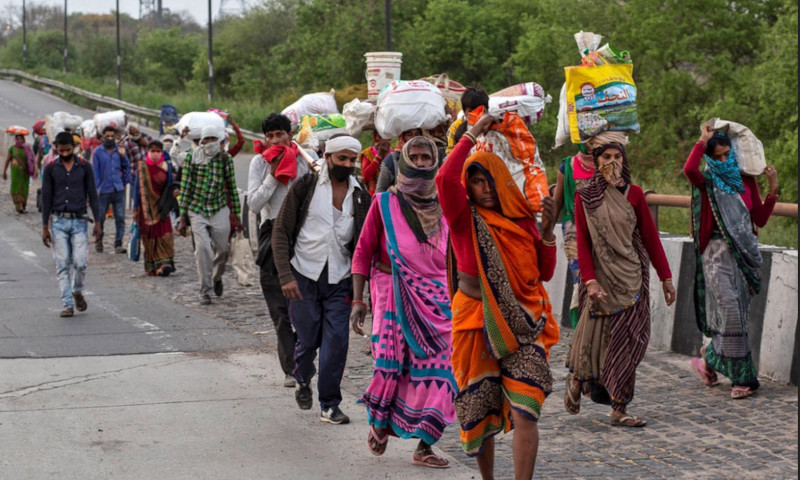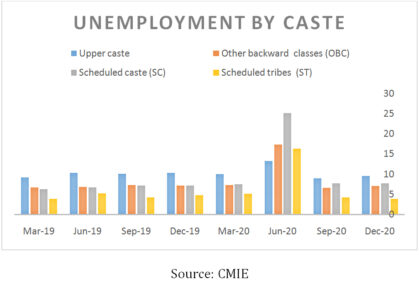Born ‘Unequal’, remained so forever: The Covid-19 reaffirmed India’s Caste, Class Inequalities
The Covid-19 induced lockdown exacerbated pre-existing labour income inequality in India and further pushed the already vulnerable sections of society to extreme edges of marginalisation on several fronts.

On March 24, 2020, with little advance notice, India’s federal government announced a strict countrywide lockdown to contain the spread of COVID-19. The Centre for Monitoring Indian Economy (CMIE), an independent body that measures and tracks economic indicators, estimated 122 million or 30.5 percent people lost their jobs in April 2020, as an aftermath of the lockdown. The number of unemployed persons spiked to 52.6 million in April 2020. The unemployment rate increased by over threefold to over 23 per cent in the months of April and May 2020 from about 7 per cent in previous months. The employment rate was 39.1 percent on March 22, 2020 which declined to 26.4 percent on May 3, 2020 before improving to 37.8 percent on June 21, 2020 (Dev and Sengupta, 2020). A survey by Azim Premji University shows that 57 percent of rural workers and 80 percent urban workers lost work during the lockdown. Millions of migrants, mostly from urban informal sector workers, made a desperate attempt to return to their villages, often walking several hundred kilometres over many days to get there. The chaotic scenes witnessed during the first week of the lockdown highlighted the precariousness of their livelihoods. The structural inequalities based on caste identity are revealed in the immediate post-lockdown job losses. Although there was some recovery with easing of the lockdown, the employment levels and income are still substantially lower than pre-lockdown levels.
Studying the aggregate data of skilled and unskilled labour from across India, provided by CMIE, it has been found that while all caste groups lost jobs in the first quarter of the lockdown (April-June 2020), the job losses for Scheduled Castes (SCs) are by far the highest. This can be explained in the words of Prof. Ashwini Deshpande, “the disproportionate effects stems from lower levels of human capital and over-representation in vulnerable jobs for the lowest ranked caste groups in the country” (Deshpande and Ramachandran, July 2020). The very existence of caste system in India leads to caste-based discrimination whereby atrocities are committed. Dr B.R. Ambedkar famously said, people are born “unequal” in this caste ridden society and are doomed to remain so. It is a hierarchical society where imputed identities dictate one’s social, economic, and political positions, and violation of rights is a primary tool to sustain the system.

Report of the Labour Bureau, based on the Fifth Annual Employment Unemployment Survey of 2015-16, conducted among different Social Groups in the country states that, according to the Usual Principal Status (UPS), worker population ratio for SCs was 50.6 percent, for Other Backward Castes (OBCs) was 47.8 percent and for Scheduled Tribes (STs) it was 54.2 percent. Although nearly half of the SCs are in the workforce, yet 16 percent among SCs hold daily-wage jobs, which are contractual, impermanent and precarious with no security. This may be explained by CMIE data which shows that the share of individuals with more than 12 years of schooling is 37 percent for upper castes and 17 percent for SCs. The privilege of higher access to education by upper castes enables them to have secure formal jobs, making them less vulnerable to economic shocks such as the one produced by the lockdown. The pandemic reaffirmed this with the majority of job losses being faced by the SCs. Though job losses were common throughout all the categories, post-lockdown, the lowest impacted were the upper caste, followed by the STs and the OBCs and the highest impacted were the SCs as compared to the jobs available in the last year during the same season. The proportion of unemployed person for the upper caste remained fairly stable while the most affected were the lower and vulnerable sections. The unemployment rate for the upper caste was around 10 percent in the in the June to August quarter of the previous year which increased to around 13 percent whereas the unemployment for OBC increased almost three times from 6.7 percent to 17.2 percent, for SC its more than four times from 6.2 percent to 25 percent and for the STs from 5.2 percent to 16.3 percent.
Major share of the casual and lower-paying worker positions in urban areas are filled by the SCs, as they migrate to these areas to escape poverty and discrimination which they face in rural areas. When the pandemic hit the urban areas harder it had a higher impact in the urban areas as compared to the rural counterparts. The upper caste was the least affected in both rural and urban areas while the SCs were the most affected for both the regions. During the lockdown, several such contractual workers were fired, and many of them are not eligible for the Prime Ministerial relief package as they are not officially registered in the urban areas where they have migrated. An article by Singh et. al (October 2020), which is based on primary data of urban Punjab traces income and employment changes through various phases of the lockdown. It reveals that income and employment losses are higher among SC and OBC households. Hence, casual labour households with the largest fall in income and employment are the most affected. A survey conducted by CEP, between May and July 2020, 8,500 workers aged 18 to 40 in urban India to understand their experiences at work during Covid-19 found that 15.5 percent workers lost their jobs and around 75 percent went without pay and corresponding financial support. 70 percent of urban workers have no guarantee of a minimum number of days of work in the year. The Covid-19 exacerbated pre-existing labour income inequality in India as those in the top quartile of pre-Covid income saw their share in total income increase by 16 percentage points within three months, whereas those in the lowest quartile of pre-Covid income saw their earnings decline by 48 percent, compared to pre-covid months of January and February 2020. A national policy commitment is needed to prevent the current earning losses from pushing many of these workers into urban poverty and the threat of long-term unemployment. This calls for an urban job guarantee scheme to address such crisis. Several states in India are debating provision of a guarantee of 100 days’ work in the year (akin to MGNREGA in rural areas), mainly to overcome the livelihood insecurity from Covid-19 or similar such shocks in the future.
The caste-based atrocities were always omnipresent in India society, but the Covid -19 induced lockdown has further pushed the already vulnerable sections of society to extreme edges of marginalisation on several fronts. The lockdown has also been witnessed a specific set of repeated patterns through which the dominant caste-based nexus has been operating to deny fundamental rights to historically and socially marginalised communities.
Sanghamitra Kanjilal-Bhaduri is Post-Doctoral Scholar at Department of Economics, University of Algarve, Faro, Portugal. Sucheta Sardar is Assistant Professor at Department of Economics, SHARDA University, Greater Noida.